Mayan ruins, tropical rainforests, surfer beaches, and colorful towns — Central America has got it all! While there may be certain challenges to be aware of, this collection of bite-size countries is affordable, (mostly) safe, and a growing backpacking hotspot.
Are you dreaming of traveling the whole region? Or maybe a specific country? Either way, scroll forth for my top tips for backpacking Central America based on my six months combined in the region.
Jump to
What’s the Gringo Trail?
If you’re looking to make an epic journey through Latin America, you will no doubt soon hear about the “gringo trail”.
Named after the Spanish slang word for foreigners, this loosely defined travel route runs all the way through Central- and South America. It is a favorite among backpackers and other overland travelers.
The Central American part of the Gringo Trail will take you at least about 2 months, give or take. This informal backpacker trail starts in Mexico’s Yucatan Peninsula, then goes down into Belize and Guatemala, and then through all the other countries until ending in Panama City.
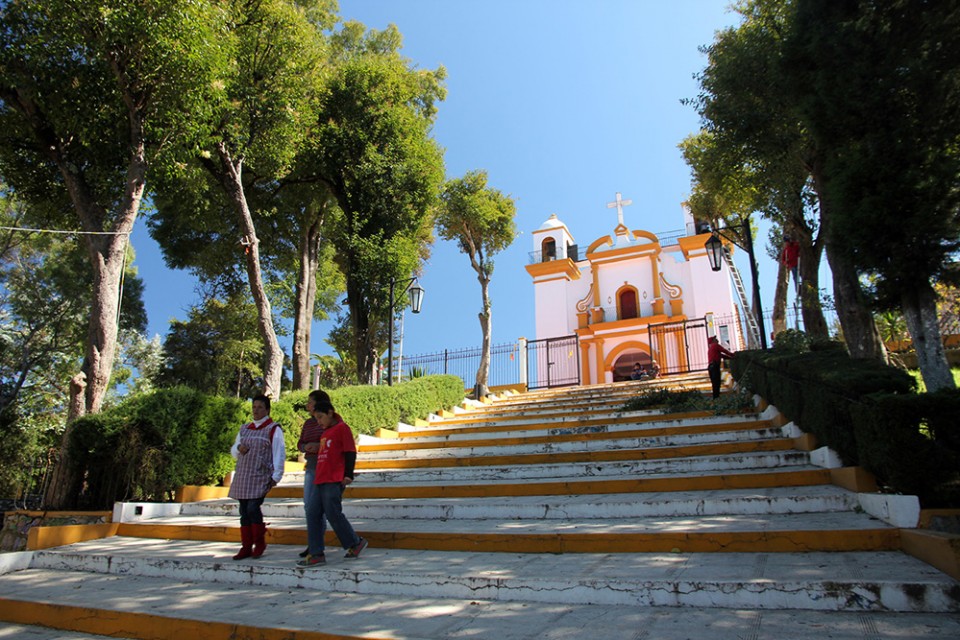
A key artery is the Pan-American Highway, which runs from the north of Mexico all the way down to Panama City along the Pacific side.
Although it’s called a ‘highway’ it’s mostly just a 2-lane road. When backpacking through Central America you’re likely to drive along many sections of it by bus. Motorbikers and other overland adventurers also follow this road often, as can be seen in the road trip documentary The Long Way Up with Ewan McGregor (a favorite travel show of mine!).
To cover the region you may end up traveling thousands of miles or kilometers, but Central America is still relatively compact. You can move around fairly quickly and visit a lot of countries in one trip.
The map below will show you roughly the ‘Gringo Trail’ that many backpackers follow.
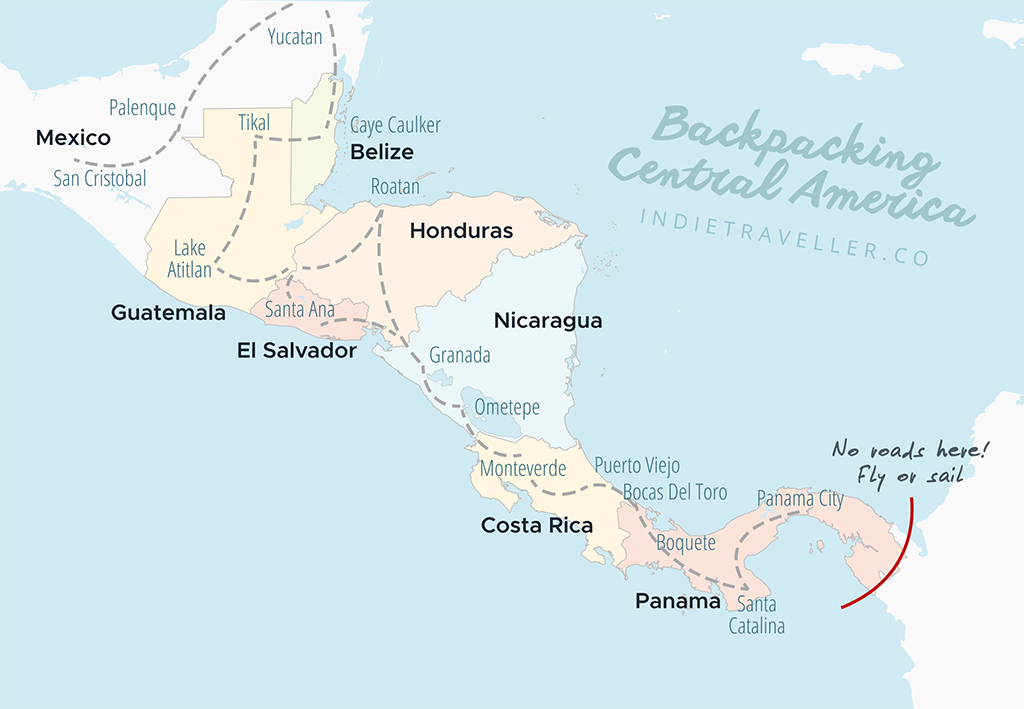
Some spots firmly on the Gringo Trail have developed into backpacker party places. For example, the Bay Islands in Honduras, San Juan del Sur in Nicaragua, or Bocas del Toro in Panama. You’ll find tons of bars, funky surf hostels, bar crawls, and all manner of entertainment in these places. Whether you wish to seek out or avoid them is up to you. They can be really fun but clearly feel less ‘authentic’.
One thing to know is that the Pacific side is easier to travel (thanks to the Pan-American Highway) while the Caribbean sides of Honduras, Nicaragua, Costa Rica, and Panama tend to be a bit more remote and less developed. If you want to go off the beaten path, these coasts can be fun to explore. For example, consider Bluefields in Nicaragua, which feels much more remote compared to Nicaragua’s Pacific coast.
You need about six weeks minimum to do the Gringo Trail route, but more is always better. I originally did it in three months but still had to skip a lot. If you have several months, you can take it a bit easier and maybe linger for a week here and there, perhaps to learn Spanish, to pick up surfing, or to volunteer.
Don’t have time for the full route? Then you can do a shorter one…
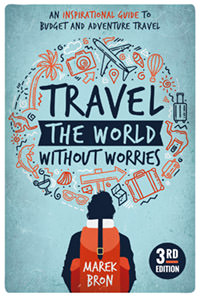
Need help with your trip?
I wrote an definitive and inspiring guidebook, which covers the whole planning process from A to Z. It teaches you everything you need to know to prepare, pack, plan, and have an amazing backpacking trip.
Shorter backpacking routes
If the Gringo Trail or a similar route seems a bit too much, why not bite off something smaller? Instead of doing the full monty, just pick two or three countries you most want to visit. Here are two perfect combos:
Southern Mexico + Guatemala
This is a great slice of Central America to cover if you have a couple of weeks. These two countries combine well in a circular route and pack a great punch.
Southeast Mexico will give you some great beaches, Mayan ruins, mountains, and jungles. It’s an amazing and easy area to travel and will give loads of variety.
Guatemala is a great adventure-filled addition to your trip. You can visit the epic Mayan temples of Tikal (easily the best and biggest in the region) and the stunning volcano lake of Atitlan.
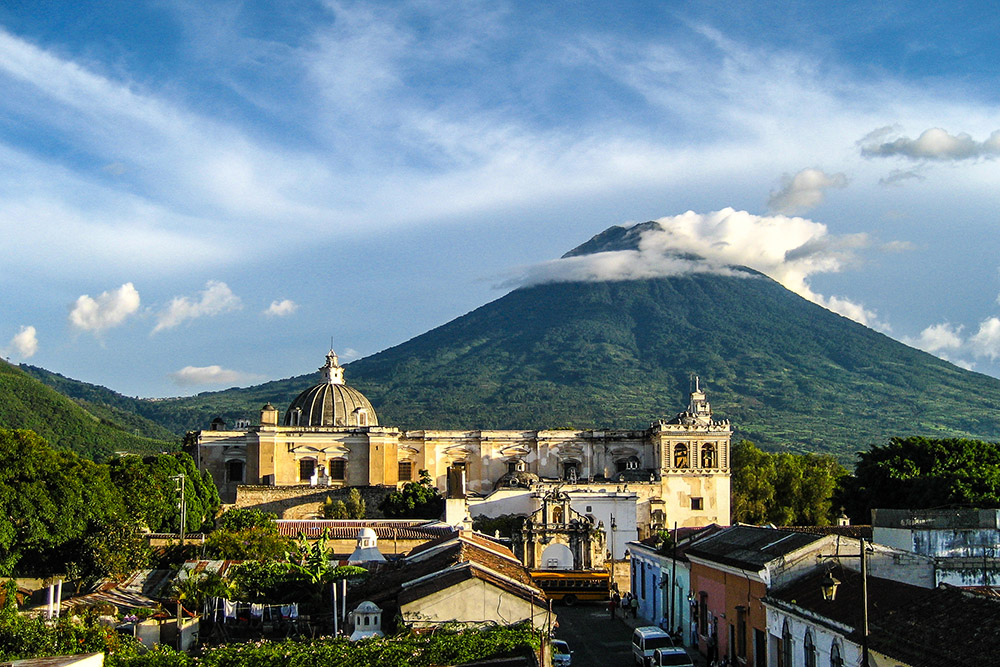
To do this route through Mexico and Guatemala, you’ll need about 2 to 3 weeks at a minimum, but more is always better.
Nicaragua + Costa Rica
Another great idea for a short trip of a week or two is to focus on Costa Rica and Nicaragua.
Famed for its wildlife and ecotourism, Costa Rica can deliver many epic moments even if you’re on a tighter schedule. In Nicaragua, many of the best destinations are in the southwest, very close to the Costa Rican border. This makes these two countries a perfect combo.
By the way, Nicaragua is way cheaper than Costa Rica, so it can lower your overall costs a lot. Don’t miss my budget travel tips for Costa Rica — you’re going to need them! It’s not a cheap country, but for many reasons many travellers consider it a bucketlist destination.
Best backpacking in Central America?
Since I had much more to say about each country in Central America, I split off my impressions into its own article. Have a look at these best countries and places to visit in Central America.
What are the hostels like?
There are loads of hostels in Central America and there are many different kinds. Don’t miss my guide to how hostels work to avoid unexpected situations.
Many hostels in Central America are like true traveler or surfer hostels; the kind of places with lots of hammocks, a barbeque, probably some dude with a guitar, a hostel dog, and lots of travel stories flowing every evening. These are for sure my favorites.
The backpacking crowd in Central America is on average somewhat older than in Europe, Australia, or countries like Thailand. As a result, most hostels are ‘all ages’ type of places.
A handful of hostels are definitely party hostels — and since this is Central America, some of them party very hard. This is where I whisper “I’ve seen things…” and probably lose myself in a dramatic flashback. I’m definitely too old and sleepy for party hostels now, but I enjoyed the scene at times when traveling Central America when I was younger. The parties in e.g. Nicaragua are rather legendary (hi there “Sunday Funday”, my old friend).
Some hostels in Central America are unique and need to be booked in advance. When I was last in Panama, I was kicking myself for not getting a spot in Bambuda Lodge hostel, which has a 150 feet water slide going into the sea, or Lost & Found, an epic hostel hidden in the jungle.
Besides hostels, there is always some sort of cheap local accommodation to find. Look for hospedajes or guesthouses. While backpacking Central America, I split my time about 50/50 between hostels and guesthouses, to have a mix of socializing and quieter time. The cost difference between a dorm bed and a budget room is usually not that big.

Getting to Central America
If you’re flying to Central America, then the most common entry points (with the most direct flights) are Mexico City, Cancun, San Jose (the capital of Costa Rica), and Panama City.
There are good connections with the US, but if you’re flying in from Europe or somewhere else further away, you may find there are relatively few (good or cheap) direct flights to Central America. If so, you might want to check if there are connecting flights through Miami International Airport or Fort Lauderdale Airport.
There aren’t many budget airlines operating within Central America. Sometimes the cheapest flight connection from, say, Guatemala City to San Jose might actually go via the United States! Once you’re in Central America, it often makes the most sense to travel overland by bus.
How to get around
There aren’t as many (budget) airline connections in Central America as there are in other parts of the world. Luckily the region is quite compact, making overlanding the sensible way to travel.
The cheapest — and arguably most fun — way to travel around is using local transportation. Various forms of bus services exist, letting you get from A to B at varying levels of comfort and speed.
Collectivos are short-distance minivan services. You can find them at bus terminals or you can usually flag them down on the road. While not that comfortable (I once had to ride one while hanging partly out of an open sliding door), they can be incredibly cheap. Riding a collectivo for one hour in one will set you back about $0.50 – $1.
Chicken buses are converted former US school buses, apparently named so because various goods including live chickens will sometimes be transported on them. They cover somewhat longer distances than the collectivos. Drivers will usually be shouting out destinations at the bus terminal, so just hop on board one that’s heading the right direction. For prices, think single-digit dollars. Typically you just get on board and pay later; an assistant usually comes to collect the money from you during the journey.
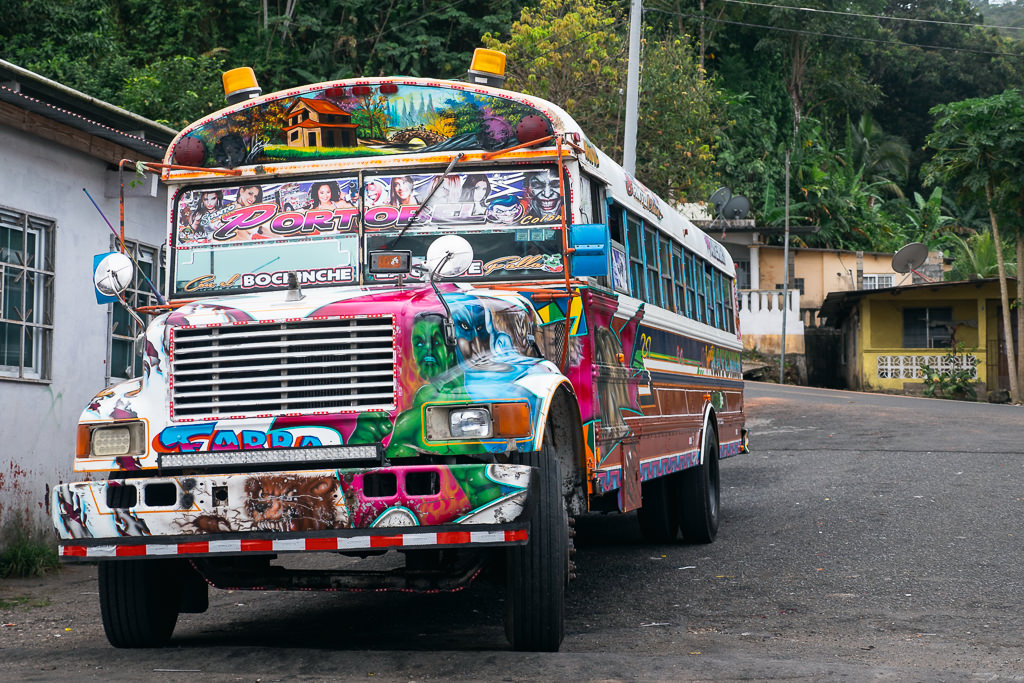
When using chicken buses, remember to keep a close eye on your bags. Some travelers don’t use chicken buses at all due to reports of crime. It’s true that generally it is not advised to use inner-city buses in capitals such as Guatemala City or Managua as these are much less safe. But outside the main cities and during the daytime, chicken buses are typically fine (but inquire locally if you’re unsure).
Long-distance coaches (usually modern two-deck buses) connect the capitals and other major hubs. Some countries also have shuttle services catering specifically to tourists. These are often a little more convenient, though they can cost as much as ten times more than the local alternatives. In Panama, I ended up using such shuttles a lot as they went directly between certain tourist destinations without any need to transfer.
Is Central America cheap?
It hugely depends where you go! Costa Rica and Belize are super expensive and many travellers would compare the prices there to Western countries. Resort-filled locations on the Mexican Yucatan coast such as Tulum and Cancun can also be very expensive. Nicaragua, Guatemala, and El Salvador are overall very inexpensive.
To give you an idea, a hostel dorm bed in Belize sets you back at least about $25 there, with private rooms starting at around $50. This is at least twice (maybe even thrice) as much as in Guatemala or Honduras.
For more details, check out my article on travel budgets in Central America.
How to travel on a budget
By and large, Central America is easy to do on a budget. You can keep costs down by focusing on the cheaper countries, as well as just keeping your day-to-day costs under control.
For the best deals, resist buying local tours or experiences online, especially through international platforms. This is because there may be quite a markup applied by those platforms and other 3rd parties. It’s often much cheaper to organize activities locally. Most tourist towns have little travel agencies offering all kinds of activities, or you can book these through a hostel or guesthouse.
Besides accommodation and tours, food is another key expense. Honestly, Central American food can be a little samey and dull, but eating the local staples like rice, beans, plantains, and so on will definitely keep your costs down. A filling set lunch at a market eatery in Nicaragua might set you back about $3.00. Not bad! Picky eaters may have to spend more, but if you just need to fuel up on a budget, you sure can do it.
Learning some Spanish can help you haggle as well as getting directions to more local places with cheap eats.
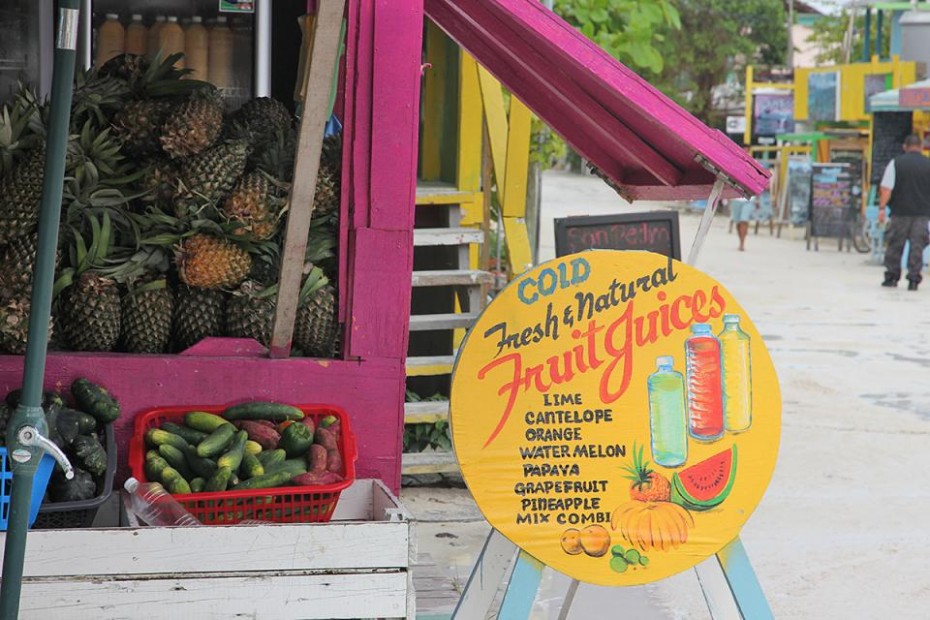
Is Central America safe?
Central America is rather safe in most countries and most of the time. In some places or countries, it’s really not so safe at all, though you can still transit safely through it. I hope that makes sense.
I used to be just all like “yaaaay, travel is amazing and you’ll never face any danger! Go with the wind!”. But as I’ve gotten more experienced, I’ve recognized the need to be a bit more nuanced. Situations can change and everyone has varying tolerance for (perceived) safety issues as well.
The bottom line is that Honduras is honestly very rough around the edges. The big cities in Belize and Guatemala also have high crime rates and it’s worth being just a bit more caution in these countries in general. You can worry less in, for example, Costa Rica and southern Mexico. El Salvador, once the world’s murder capital, has been among the safest places recently due to the many changes taking place there.
Just don’t jump in without any self-awareness or a complete lack of knowledge of the local situation. You can read a few specific safety tips for Central America. It may also help to have traveled in other parts of the world first; Europe, Asia, or even many parts of South America are easier if you’re going on your first-ever backpacking trip.
For additional peace of mind, be sure to have some comprehensive travel insurance. This will ensure you’re covered in the case of any accident or theft. You can get travel insurance at Heymondo, which I use myself and recommend for any backpacking trips.
Pssst, don’t forget your travel insurance!
Insurance in itself won’t keep you safe, but it will protect you from any financial issues if anything happens. Insurance from Heymondo covers you for medical emergencies, theft, travel delay, cancellation, lost luggage, and more.
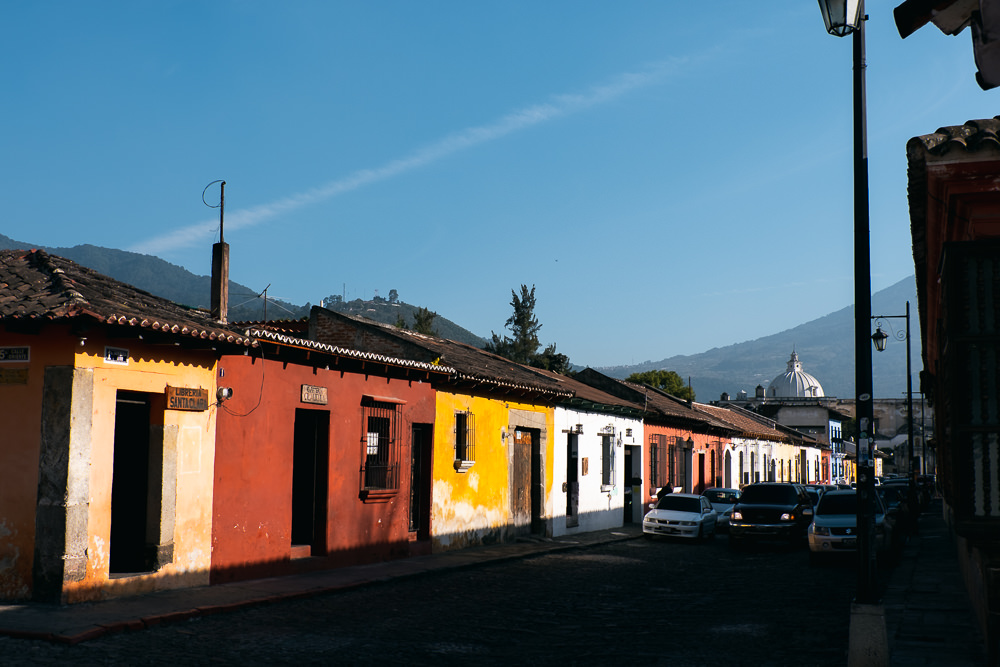
What’s the best time to go?
The best time to travel Central America is during the dry season. The exact timing of this is different in each country, but broadly speaking the dry season is between November and April.
That doesn’t mean the ‘wet season’ is all that bad. I was in Guatemala in September, which is supposedly the worst month, but I wouldn’t really have guessed it at the time. Maybe I got lucky, but I had a great experience.
Sure, it rained a couple of times. Annoyingly, it rained while visiting the incredible ruins of Tikal. Yet the tourist sights were also free of crowds and the jungles were especially lush and green. I visited Panajachel on Lake Atitlan during September and it was super chill; when I came back in December it was a cacophony of souvenir sellers, tour operators, and so on. Quite a shocking difference!
Still, the common advice is to avoid the months of July to September. Come to think of it, I did also witness the ravages of a tropical storm in Mexico during this time. I guess the dry season does offer more assurances of good weather and good vibes. If forced to travel during the rainy season, you still can though.
Keep in mind that Mexico and Costa Rica, popular as they are with American holidaymakers, will fill up a lot during US holidays such as 4th of July.
Do you need to know Spanish?
No necesitas saber español para viajar por Centroamérica, pero definitivamente te ayuda!
Sorry.
What I mean to say is that Spanish knowledge is definitely helpful. Few people in Latin America are multi-lingual and English is not widely spoken, so any Spanish you can muster will certainly be a plus.
Can you still survive without Spanish? Well, sure! Most hostels have staff members that speak different languages. Local hospedajes or guesthouses might not, but the things you need to communicate (payment, wifi passwords, food, etc.) are not exactly hard to guess.
I was with a travel buddy who knew absolutely zero Spanish. All he knew to say was ‘necesito’ (‘I need’) followed by some gesture, pointing, or showing a picture of what he needed. He got through South- and Central America without a hitch. Of course, Google Translate can also be of great help.
Nevertheless, knowing some Spanish will pay dividends throughout your trip. One thing I love about backpacking in Latin America is that you can get much closer to the local culture. In Asia, for instance, I often felt a bit trapped in the tourist bubble, usually unable to communicate with anyone local (learning Thai or Vietnamese is a bit beyond my abilities). In Latin America I could chit-chat with passengers on the bus or even date locals, adding a different dimension to the experience.
A trip through Central America is a good excuse to take at least a few Spanish classes somewhere. Chances are these classes will be cheaper than you’ll ever be able to get them at home. In another post I share my experiences with learning Spanish while traveling in Central America.
Top experiences in Central America
The region is dotted with volcanoes throughout, so while you’re here, you should climb a volcano at least once!
In Guatemala, I climbed up Tajamulco volcano at night to catch the sunrise, which was just out of this world. In Nicaragua, I hiked up to Telica volcano, which was active at the time, and you could peek over the edge and see the lava down below. Simply unforgettable. Many backpackers also speak highly of the volcanoes near Antigua, Guatemala. In Nicaragua, you can also go volcano boarding (sliding down a volcano like a sled).
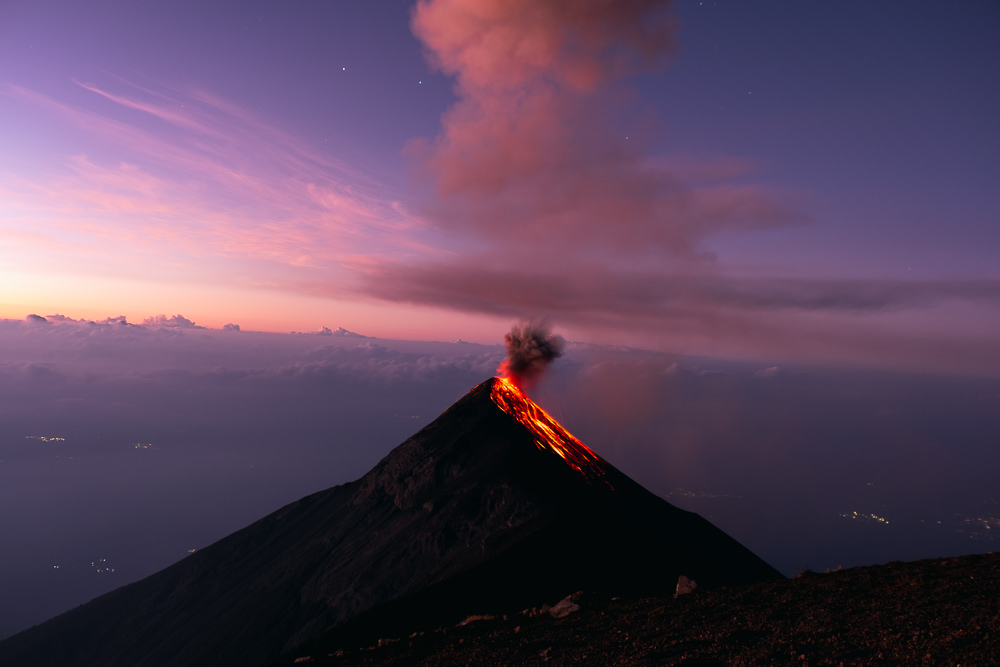
The jungles and cloud forests of Costa Rica are not to miss. Do a day hike or, better yet, get a jungle tour at night with a good guide. I was amazed at how much wildlife you could see at close range.
The epic Mayan ruins of Tikal in Guatemala are another incredible highlight. It’s a popular tourist destination but not as crowded as the different ruins in Mexico, and it’s surrounded by jungle in a remote location, adding to its mystique. Consider getting up early to catch the sunrise from one of the temples. Lake Atitlan and Semuc Champey are two other must-go places in Guatemala.
While backpacking Central America you’ll have some great opportunities to learn to surf. I absolutely suck at surfing but still enjoy trying. Lots of cheap lessons can be had especially in El Salvador, Panama, or Nicaragua.
In Mexico, it’s worth being there around Day of the Dead and other local festivities. The country as a whole is a real cultural and culinary highlight. The cenotes (river caves) in the Yucatan are amazing. You can snorkel through them or even scuba dive.
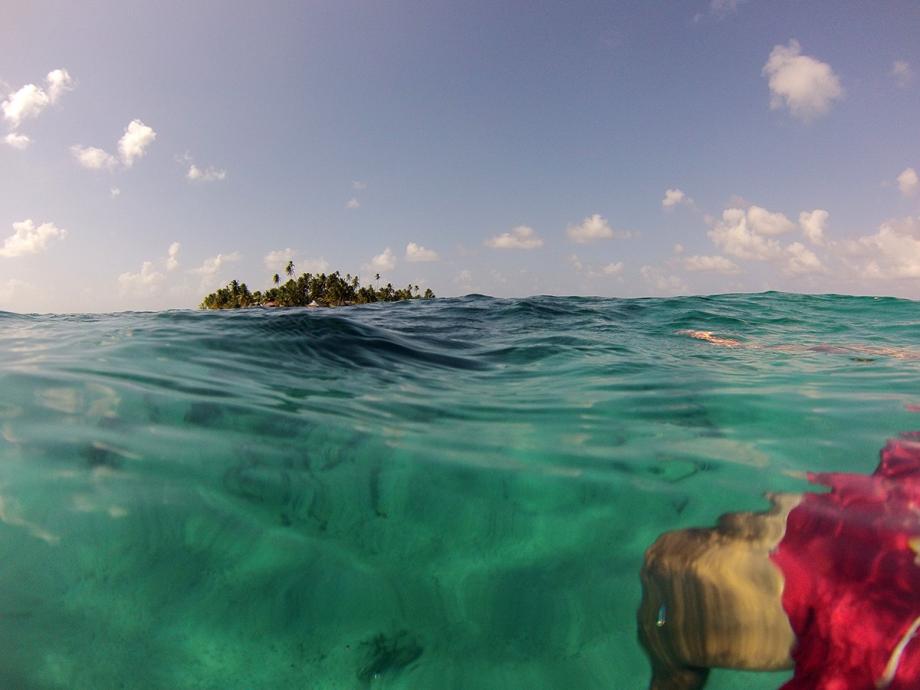
Finally, I loved the San Blas Islands off the coast of Panama. I saw these on my way to Colombia and it was one of the real highlights. My memories of staying on nearly uninhabited islands and snorkeling with giant manta rays are pretty much burned into my neurons forever.
Keep in mind that should you wish to continue your journey to South America, it’s not possible overland!
There’s a huge stretch of impenetrable and dangerous jungle in the east of Panama called the Darien Gap. There are no roads at all through the Darien Gap so you will either have to fly or sail around. I can much recommend sailing between Panama and Colombia. Many captains operate private services taking travelers to and from Cartagena. It’s an incredible 5-day trip that takes you past the San Blas Islands.
If you’re still on the fence about backpacking Central America, I hope I’ve inspired you to get off that damn fence and to start planning your trip! You definitely won’t regret backpacking Central America.
P.S. Did you find this post useful but you could use more detailed help? Then check out my book, Travel the World Without Worries. Readers have called it their “single best pre-trip purchase” and “comprehensive, informational, funny and inspiring”. I guarantee it will better prepare you for all the challenges (and fun) of backpacking Central America.
Some links may be affiliate links, meaning I may earn commission from products or services I recommend. For more, see site policies.
